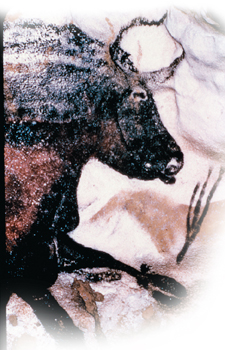Modern Humans The story of modern humans over the past 200,000 years involves two main species in the genus Homo.
▸ Homo neanderthalensis Neanderthals flourished in Europe and western Asia beginning about 200,000 years ago. Evidence suggests that they made stone tools, lived in complex social groups, had controlled use of fire, and were excellent hunters. They buried their dead with simple rituals. Neanderthals survived in parts of Europe until about 28,000 to 24,000 years ago.
▸ Modern Homo sapiens Anatomically modern Homo sapiens, whose skeletons look like those of today's humans, arrived in the Middle East from Africa about 100,000 years ago. By about 50,000 years ago, H. sapiens populations were using new technology to make more sophisticated stone blades. They also began to make elaborately worked tools from bones and antlers. They produced spectacular cave paintings and buried their dead with elaborate rituals. In other words, these people, including the group known as Cro-Magnons, began to behave like modern humans.
When H. sapiens arrived in the Middle East, they found Neanderthals already living there. Neanderthals and H. sapiens lived side by side in the Middle East for about 50,000 years. Groups of modern humans moved into Europe between 40,000 and 32,000 years ago. There, too, H. sapiens coexisted alongside Neanderthals for several thousand years. For the last 24,000 years, however, our species has been Earth's only hominine. Why did Neanderthals disappear? Did they interbreed with H. sapiens? No one knows for sure. What we do know is that our species, Homo sapiens, is the only surviving member of the once large and diverse hominine clade.

FIGURE 26–21 Cro-Magnon Art This ancient cave painting from France shows the remarkable artistic abilities of Cro-Magnons. Infer How might these painted images be related to the way in which these early humans lived?
26.3 Assessment

-
Review What are the characteristics of primates?
Apply Concepts How does each characteristic benefit primates?
-
Review List the two major groups of primates.
Sequence At what point did the two groups of anthropoids split, and why?
-
Review Which early hominine bones changed shape over time, allowing later hominines to walk upright?
Relate Cause and Effect How was bipedal locomotion important to hominine evolution?
-
Review Which two species are considered humans?
Compare and Contrast List two ways in which Homo neanderthalensis differed from Homo sapiens.
WRITE ABOUT SCIENCE
Create a “Lost Hominine” poster for Homo neanderthalensis. Include its known characteristics and approximately when and where it was last seen. Illustrate the poster with a drawing or clipping.

Table of Contents
- Formulas and Equations
- Applying Formulas and Equations
- Mean, Median, and Mode
- Estimation
- Using Measurements in Calculations
- Effects of Measurement Errors
- Accuracy
- Precision
- Comparing Accuracy and Precision
- Significant Figures
- Calculating With Significant Figures
- Scientific Notation
- Calculating With Scientific Notation
- Dimensional Analysis
- Applying Dimensional Analysis




